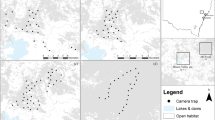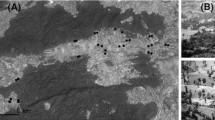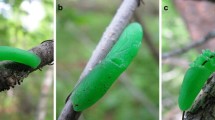Abstract
In recent decades, the consequences of habitat fragmentation have been of growing concern, because it is particularly important to understand how fragmentation may affect biodiversity, an ecological service. We tested two hypotheses: (1) that natural fragment size in agricultural landscapes indirectly affects the herbivore through effects on natural predator populations; and (2) predator activity into the crop reduces along the distance from the natural fragment edge. From 2008 and 2009, we conducted our study in seven forest remnants and in surrounding coffee plantations (fragments ranged from 6 to 105 ha, mean 49.28 ± 36.60 ha) in Southern Minas Gerais, Brazil. Birds were sampled by point counts, and insect predation was evaluated by using an artificial insect model (Koh and Menge 2006). Our results suggest that although there were many potential predators (e.g., wasps, ants, birds, and mammals), birds were the most important taxon unit. The covariance analysis supported the hypothesis that patch size affected the number of larvae predation by overall taxi, but there was no support for a distance effect. These findings suggest that natural enemies’ ecological service (mainly from birds) declined with remnant reduction, which has implications not only for human welfare, but also in strengthening the economic justifications for conserving the remaining natural habitats and biodiversity in agricultural landscapes.





Similar content being viewed by others
References
Altegrim O (1989) Exclusion of birds from bilberry stands: impact on insect larval density and damage to the bilberry. Oecologia 79:136–139
Barbaro L, Battisti A (2011) Birds as predators of the pine processionary moth (Lepidoptera: Notodontidae). Biol Control 56(2):107–114
Bianchi FJJA, Wäckers FL (2008) Effects of flower attractiveness and nectar availability in field margins on biological control by parasitoids. Biol Control 46:400–408
Bianchi FJJA, Booij CJH, Tscharntke T (2006) Sustainable pest regulation in agricultural landscapes: a review on landscape composition, biodiversity and natural pest control. Proc R Soc Biol Sci Ser B 273(1595):1715–1727
Bianchi FJJA, Goedhart PW, Baveco JM (2008) Enhanced pest control in cabbage crops near forest in The Netherlands. Landsc Ecol 23(5):595–602
Borkhataria RR, Collazo JA, Groom MJ (2006) Additive effects of vertebrate predators on insects in a Puerto Rican coffee plantation. Ecol Appl 16(2):696–703
Burnham KP, Anderson DR (2002) A practical information-theoretic approach, Second edn. Springer, New York, p 353
Comitê Brasileiro de Registros Ornitológicos—CBRO (2011) Lista das aves do Brasil. 10th edn. CBRO. http://www.cbro.org.br. Accessed 15 Nov 2011
Connor EF, Courtney AC, Yoder JM (2000) Individuals–area relationships: the relationship between animal population density and area. Ecology 81(3):734–748
Costa CMR (1998) Biodiversidade em Minas Gerais: um atlas para a sua conservação. Fundação Biodiversitas, Belo Horizonte, p 222
Cronin JT (2003) Matrix heterogeneity and host-parasitoid interactions in space. Ecology 84:1506–1516
Cronin JT, Haynes KJ, Dillemuth F (2004) Spider effects on planthopper mortality, dispersal and spatial population dynamics. Ecology 85:2134–2143
Daily GC (1997) Introduction: what are ecosystem services? In: Daily G (ed) Nature’s services: societal dependence on natural ecosystems. Island Press, Washington, D.C, pp 1–10
Denno RF, Finke DL, Langellotto GA (2005) Direct and indirect effects of vegetation structure and habitat complexity on predator–prey and predator–predator interactions. In: Barbosa P, Castellanos I (eds) Ecology of predator–prey interactions. Oxford University Press, Oxford, pp 211–239
Develey P (2003) Métodos com estudos com aves. In: Cullen L Jr, Rudran R, Valladares-Pádua C (eds) Métodos de estudos em biologia da conservação e manejo da vida silvestre. Editora Universidade Federal do Paraná, Curitiba, pp 153–179
Fahrig L (2003) Effects of habitat fragmentation on biodiversity. Annu Rev Ecol Syst 34:487–515
Fitzpatrick JW (1980) Foraging behavior of neotropical tyrant flycatchers. Condor 82(1):43–57
Fragoso DB, Jusselino-Filho P, Guedes RNC, Proque R (2001) Seletividade de inseticidas a vespas predadoras de Leucoptera coffeella (Guér.-Mènev.) (Lepidoptera: Lyonetiidae). Neotrop Entomol 30(1):139–143
Freitas AVL, Oliveira PS (1996) Ants as selective agents on herbivore biology: effects on the behaviour of a non-myrmecophilous butterfly. J Anim Ecol 65:205–210
Fundação SOS Mata Atlântica & (INPE) Instituto Nacional de Pesquisas Espaciais (2009) Atlas dos remanescentes florestais da Mata Atlântica, período de 2005–2008. Fundação SOS Mata Atlântica & São Jose dos Campos, INPE, São Paulo
Gomes VSM, Loiselle BA, Alves MAS (2008) Birds foraging for fruits and insects in shrubby restinga vegetation, southeastern Brazil. Biota Neotrop 8(4):21–31
Greenberg R, Bichier P, Angon AC, MacVean C, Perez R, Cano E (2000) The impact of avian insectivory on arthropods and leaf damage in some guatemalan coffee plantations. Ecology 81(6):1750–1755
Henle K, Davies KF, Kleyer M, Margules C, Settele J (2004) Predictors of species sensitivity to fragmentation. Biodivers Conserv 13:207–251
Johnson MD, Levy NJ, Kellermann JL, Robinson DE (2009) Effects of shade and bird exclusion on arthropods and leaf damage on coffee farms in Jamaica’s Blue Mountains. Agrofor Syst 76(1):139–148
Jonsson M, Wratten SD, Landis DA, Tompkins J-ML, Cullen R (2010) Habitat manipulation to mitigate the impacts of invasive arthropod pests. Biol Invasions 12(9):2933–2945
Kellermann JL, Johnson MD, Stercho AM, Hackett SC (2008) Ecological and economic services provided by birds on Jamaican Blue Mountain coffee farms. Conserv Biol 22(5):1177–1185
Klein A-M, Steffan-Dewenter I, Tscharntke T (2006) Rain forest promotes trophic interactions and diversity of trap-nesting Hymenoptera in adjacent agroforestry. J Anim Ecol 75(2):315–323
Koh LP, Menge DNL (2006) Rapid assessment of Lepidoptera predation rates in neotropical forest fragments. Biotropica 38(1):132–134
Landis DA, Wratten SD, Gurr GM (2000) Habitat management to conserve natural enemies of arthropod pests in agriculture. Annu Rev Entomol 45:175–201
Langellotto GA, Denno RF (2004) Responses of invertebrate natural enemies to complex-structured habitats: a meta-analytical synthesis. Oecologia 139:1–10
Lomeli-Flores JR (2009) Natural enemies and mortality factors of the coffee leafminer Leucoptera coffeella (Guerin-Meneville) (Lepidoptera: Lyonetiidae) in Chiapas, México. PhD Dissertation, Texas A&M University, Texas, p 203
MacArthur RH, Wilson EO (1967) The theory of island biogeography. Princeton University Press, Princeton, p 203
Oliveira Filho AT, Fontes MAL (2000) Patterns of floristic differentiation among Atlantic Forests in Southeastern Brazil and the influence of climate. Biotropica 32:793–810
Parra J (1985) Biologia comparada de Leucoptera coffeella (Guérin-Méneville, 1842) (Lepidoptera: Lyonetiidae) visando o seu zoneamento ecológico no Estado de São Paulo. Rev Bras Entomol 29:45–76
Pimentel D, Wilson C, McCullum C, Huang R, Dwen P, Flack J, Tran Q, Saltman T, Cliff B (1997) Economic and environmental benefits of biodiversity. Bioscience 47:747–757
Polis GA, Strong DR (1996) Food web complexity and community dynamics. Am Nat 147:813–846
Puckett HL, Brandle JR, Johnson RJ, Blankenship EE (2009) Avian foraging patterns in crop field edges adjacent to woody habitat. Agric Ecosyst Environ 131(1–2):9–15
Reis R Jr, Lima ER, Vilela EF, Evaldo F, Barros RS (2000) Method for maintenance of coffee leaves in vitro for mass rearing of Leucoptera coffeellum (Guérin-Méneville) (Lepidoptera: Lyonetiidae). An Soc Entomol Bras 29(4):849–854
Remsen JV, Robinson SK (1990) A classification scheme for foraging behavior of birds in terrestrial habitats. Stud Avian Biol 13:144–160
Ridgely RS, Tudor G (1994) The birds of South America: volume 1: the suboscine passerines. University of Texas Press, Austin, p 598
Ridgely RS, Tudor G (1997) The birds of South America: volume 2: the oscine passerines. University of Texas Press, Austin, p 940
Root RB (1973) Organization of a plant-arthropod association in simple and diverse habitats: the fauna of collards (Brassica oleraceae). Ecol Monogr 45:95–120
Sick H (2001) Ornitologia brasileira. Nova Fronteira, Rio de Janeiro, p 912
Sodhi NS, Ehrlich PR (2010) Conservation biology conservation biology for all. Oxford University Press, Oxford, p 344
Stotz DF, Fitzpatrick JW, Parker TA III, Moskovitz DK (1996) Neotropical birds: ecology and conservation. University of Chicago Press, Chicago, p 502
Strong DR (1992) Are trophic cascades all wet? Differentiation and donor-control in species ecosystems. Ecology 73:747–754
Strong DR, Sherry TW, Holmes RT (2000) Bird predation on herbivorous insects: indirect effects on sugar maple saplings. Oecologia 125:370–379
Tilman D, Reich PB, Knops J, Wedin D, Mielke T, Lehman C (2001) Diversity and productivity in a long-term grassland experiment. Science 294:843–845
Tscharntke T, Rand TA, Bianchi FJJA (2005) The landscape context of trophic interactions: insect spillover across the crop–noncrop interface. Ann Zool Fenn 42:421–432
Tscharntke T, Bommarco R, Clough Y, Crist TO, Kleijn D, Rand TA, Tylianakis JM, Nouhuys SV, Vidal S (2007) Conservation biological control and enemy diversity on a landscape scale. Biol Control 43:294–309
Van Bael SA, Philpott SM, Greenberg R, Bichier P, Barber NA, Mooney KA, Gruner DS (2008) Birds as predators in tropical agroforestry systems. Ecology 89(4):928–934
Vergara PM, Hahn I (2009) Linking edge effects and patch size effects: importance of matrix nest predators. Ecol Model 220(9–10):1189–1196
Whelan CJ, Wenny DG, Marquis RJ (2008) Ecosystem services provided by birds. Ann N Y Acad Sci 1134:25–60
Willis EO (1979) The composition of avian communities in remanescent woodlots in southern Brazil. Pap Avulsos Zool (Sao Paulo) 33(1):1–25
With KA (2002) Threshold effects of landscape structure on biological control in agroecosystems. Ecol Appl 13(1):314–365
Zambolim L, Conceição MZD, Santiago T (2008) O que engenheiros agrônomos devem saber para orientar o uso de produtos fitossanitários, 3a edn. Universidade Federal de Viçosa, ANDEF, Viçosa, p 464
Acknowledgments
We wish to express our gratitude to M. Raniero, M. F. V. Silva, E. Pessoni, and other members of the Laboratório de Ecologia de Fragmentos Florestais (ECOFRAG), who have been valuable friends, assisted in fieldwork, and made essential comments at different phases of this study. This manuscript also greatly benefited from the comments of Alberto José Arab Olavarrieta. We also thank several private landowners who permitted access to their properties. Universidade Federal de Alfenas provided logistical support. We received financial support from Fundação de Amparo à Pesquisa do Estado de Minas Gerais FAPEMIG-VALE S/A (Process #RDP-00104-10) and Conselho Nacional de Desenvolvimento Científico e Tecnológico (CNPq) (Process # 472250/2010). We appreciated the improvements in English language made by Jim Hesson of http://www.AcademicEnglishSolutions.com
Author information
Authors and Affiliations
Corresponding author
Additional information
Project funding: This work is financially supported from Fundação de Amparo à Pesquisa do Estado de Minas Gerais FAPEMIG-VALE S/A (Process #RDP-00104-10) and Conselho Nacional de Desenvolvimento Científico e Tecnológico (CNPq) (Process # 472250/2010).
The online version is available at http://www.springerlink.com
Corresponding editor: Chai Ruihai
Rights and permissions
About this article
Cite this article
Jordani, M.X., Hasui, É. & da Silva, V.X. Natural enemies depend on remnant habitat size in agricultural landscapes. J. For. Res. 26, 469–477 (2015). https://doi.org/10.1007/s11676-015-0043-y
Received:
Accepted:
Published:
Issue Date:
DOI: https://doi.org/10.1007/s11676-015-0043-y




